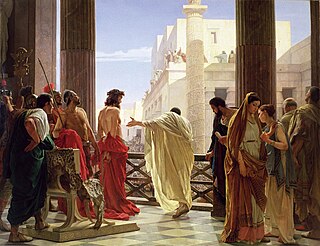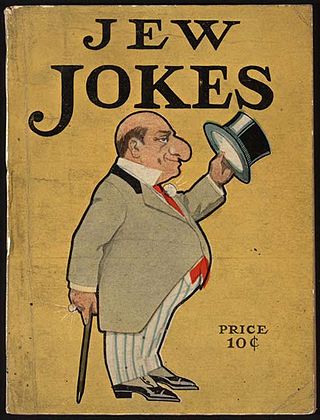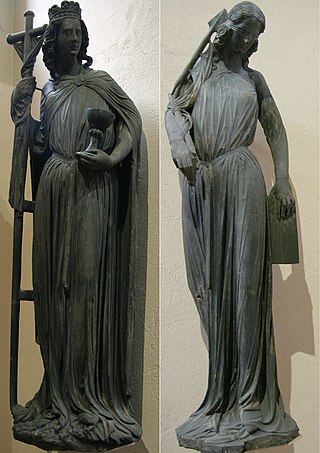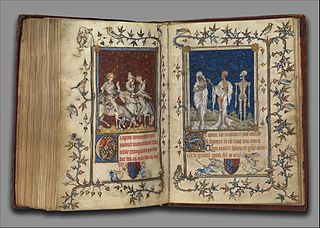Related Research Articles
Antisemitism is hostility to, prejudice towards, or discrimination against Jews. A person who holds such positions is called an antisemite. Antisemitism is considered to be a form of racism.

Blood libel or ritual murder libel is an antisemitic canard which falsely accuses Jews of murdering Christian boys in order to use their blood in the performance of religious rituals. Historically, echoing very old myths of secret cultic practices in many prehistoric societies, the claim as it is leveled against Jews, was rarely attested to in antiquity. It was however, frequently attached to early communities of Christians in the Roman Empire, re-emerging as a European Christian accusation against Jews in the medieval period. This libel—alongside those of well poisoning and host desecration—became a major theme of the persecution of Jews in Europe from that period to the present day.

Pontius Pilate was the fifth governor of the Roman province of Judaea, serving under Emperor Tiberius from 26/27 to 36/37 AD. He is best known for being the official who presided over the trial of Jesus and ultimately ordered his crucifixion. Pilate's importance in modern Christianity is underscored by his prominent place in both the Apostles' and Nicene Creeds. Due to the Gospels' portrayal of Pilate as reluctant to execute Jesus, the Ethiopian Church believes that Pilate became a Christian and venerates him as both a martyr and a saint, a belief which is historically shared by the Coptic Church.
Philosemitism is a notable interest in, respect for, and appreciation of the Jewish people, their history, and the influence of Judaism, particularly on the part of a non-Jew. In the aftermath of World War II, the phenomenon of philosemitism saw a great increase throughout Europe following the Holocaust, reshaping the relationship between Jews and European societies. American historian G. Daniel Cohen states that philosemitism "can indeed easily recycle antisemitic themes, recreate Jewish otherness, or strategically compensate for Holocaust guilt".

The medieval art of the Western world covers a vast scope of time and place, over 1000 years of art in Europe, and at certain periods in Western Asia and Northern Africa. It includes major art movements and periods, national and regional art, genres, revivals, the artists' crafts, and the artists themselves.

William of Norwich was an English boy whose disappearance and killing was, at the time, attributed to the Jewish community of Norwich. It is the first known medieval accusation against Jews of ritual murder.

The Jewish hat, also known as the Jewish cap, Judenhut (German) or Latin pileus cornutus, was a cone-shaped pointed hat, often white or yellow, worn by Jews in Medieval Europe. Initially worn by choice, its wearing was enforced in some places in Europe after the 1215 Fourth Council of the Lateran for adult male Jews to wear while outside a ghetto to distinguish them from others. Like the Phrygian cap that it often resembles, the hat may have originated in pre-Islamic Persia, as a similar hat was worn by Babylonian Jews.
Howard Eric Jacobson is a British novelist and journalist. He is known for writing comic novels that often revolve around the dilemmas of British Jewish characters. He is a Man Booker Prize winner.
The race and appearance of Jesus has been a topic of discussion since the days of early Christianity. Various theories about the race of Jesus have been proposed and debated. By the Middle Ages, a number of documents, generally of unknown or questionable origin, had been composed and were circulating with details of the appearance of Jesus. These documents are now mostly considered forgeries.

The history of the Jews in Denmark goes back to the 1600s. At present, the Jewish community of Denmark constitutes a small minority of about 6,000 persons within Danish society. The community's population peaked prior to the Holocaust at which time the Danish resistance movement took part in a collective effort to evacuate about 8,000 Jews and their families from Denmark by sea to nearby neutral Sweden, an act which ensured the safety of almost all the Danish Jews.
Antisemitism in the history of the Jews in the Middle Ages became increasingly prevalent in the Late Middle Ages. Early instances of pogroms against Jews are recorded in the context of the First Crusade. Expulsions of Jews from cities and instances of blood libel became increasingly common from the 13th to the 15th century. This trend only peaked after the end of the medieval period, and it only subsided with Jewish emancipation in the late 18th and 19th centuries.
Antisemitic tropes, canards, or myths are "sensational reports, misrepresentations, or fabrications" that are defamatory towards Judaism as a religion or defamatory towards Jews as an ethnic or religious group. Since the Middle Ages, such reports have been a recurring motif of broader antisemitic conspiracy theories.

Stereotypes of Jews are generalized representations of Jews, often caricatured and of a prejudiced and antisemitic nature.

Ecclesia and Synagoga, or Ecclesia et Synagoga in Latin, meaning "Church and Synagogue", are a pair of figures personifying the Church and the Jewish synagogue, that is to say Judaism, found in medieval Christian art. They often appear sculpted as large figures on either side of a church portal, as in the most famous examples, those at Strasbourg Cathedral. They may also be found standing on either side of the cross in scenes of the Crucifixion, especially in Romanesque art, and less frequently in a variety of other contexts.

The Jewish nose, or Jew's nose, is an ethnic stereotype that refers to a hooked nose with a convex nasal bridge and a downward turn of the tip of the nose. The Jewish nose was singled out as a hostile caricature of Jews in mid-13th century Europe and has since become a defining and persisting element of the Jewish stereotype. In modern times, it has also been adopted by many Jews as a part of their ethnic identity.

The Psalter of Bonne de Luxembourg is a small 14th-century illuminated manuscript in tempera, grisaille, ink and gold leaf on vellum. It is held in the collection of The Cloisters, New York, where it is usually on display.

The Birds' Head Haggadah is the oldest surviving illuminated Ashkenazi Passover Haggadah. The manuscript, produced in the Upper Rhine region of Southern Germany in the early 14th century, contains the full Hebrew text of the Haggadah, a ritual text recounting the story of Passover – the liberation of the Israelites from slavery in ancient Egypt – which is recited by participants at a Passover Seder. The text is executed in block calligraphy and accompanied by colorful illustrations of Jews performing the Seder practices and reenacting Jewish historical events. The Birds' Head Haggadah is so called because all Jewish men, women, and children depicted in the manuscript have human bodies with the faces and beaks of birds. Non-Jewish and non-human faces are blank or blurred. Numerous theories have been advanced to explain the unusual iconography, usually tied to Jewish aniconism. The Haggadah is in the possession of the Israel Museum in Jerusalem, where it is on permanent exhibition.
Robert Michael (1936–2010) was a Professor Emeritus of European History at the University of Massachusetts Dartmouth. He is the father of singer-songwriter Avi Jacob.
Jews, Money, Myth is an exhibition held at the Jewish Museum London in 2019. It was made in collaboration with the Pears Institute for the Study of Antisemitism.

The Happy Merchant is a common name for an image that depicts an antisemitic caricature of a Jewish man. The Happy Merchant is common on imageboards such as 4chan where it is frequently used in a hateful or disparaging context.
References
- ↑ Kahn, Eve (30 October 2014). "Not All Medieval Sacred Art Was Anti-Semitic". New York Times. Retrieved 22 May 2019.
- ↑ Pearl, Sharrona (8 February 2009). "The Myth of the Jewish Nose". Tablet . Retrieved 22 May 2019.
- 1 2 Jacobson, Howard (17 April 2019). "Jews and the money myth From Judas to the Brick Lane mural, how the malicious libel about Jewish greed gripped the global imagination". New Statesman . Retrieved 21 May 2019.
- ↑ Roth, Michael (19 December 2014). "'Dark Mirror,' on origins of anti-Jewish iconography (book review)". Washington Post. Retrieved 22 May 2019.
- ↑ Chazan, Robert (5 April 2015). "When Did Christian Art Begin Singling Out Jews? (book review)". Haaretz . Retrieved 22 May 2019.
- ↑ "Dark Mirror (brief review)". The New Yorker . 9 February 2015. Retrieved 22 May 2019.
- ↑ Christiansen, Eric (9 July 2015). "Two Cheers for the Middle Ages! (book review)". New York Review of Books . Retrieved 22 May 2019.